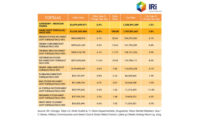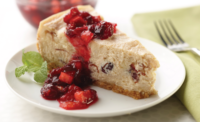Whether consumers are looking to eat breakfast on the go, refuel after a workout, or indulge in a tasty but nutritious treat, there are more choices than ever when it comes to bars. If you ask Jessica Gardeck, associate channel manager, platform marketing and innovation, General Mills Convenience & Foodservice, Minneapolis, the bar space can be divided up into four main categories: mainstream grain, performance, wellness, and treat. “Each of these areas offers consumers something very different,” she says. “For instance, there are consumers seeking out a bar that offers protein (performance), while others may be seeking out an option that accommodates a particular dietary need or preference, whether it’s gluten-free or keto (wellness).”
In a category capable of appealing to such a wide range of consumers, it’s no surprise that, sales-wise, things are holding strong.
Overview | Bread | Tortillas | Sweet Goods | Snack Cakes | Pizza | Desserts | Cookies | Buns & Rolls | Bars | Breakfast Products
Market data
According to IRI, Chicago, sales of snack and granola bars held steady during the 52 weeks ending April 19, 2020, posting 1.4 percent growth and reaching $6.4 billion.
The nutritional and intrinsic health bar segment makes up the majority of the market share and posted $3.4 billion in sales, up 2.0 percent over the past year. The Atkins brand, owned by The Simply Good Foods Co., had a strong year, up 12.9 percent to $247.6 million, making up the bulk of the company’s sales in this segment. RX Bar also had a strong showing, categorized under Kellogg Co.’s Insurgent Brands business unit, up 7.8 percent to $143.3 million. Slim Fast’s Keto bars also had a very strong year, up 287.4 percent to $77.4 million.
Sales of breakfast and cereal bars grew 5.6 percent over the past year to reach $1.5 billion. Kellogg Co.’s Rice Krispies Treads breakfast bars grew 4.4 percent to $336.8 million, comprising over half of the company’s revenue in the segment. The brand got a boost from the bite-sized, snackable Rice Krispies Treats Snap Crackle Poppers, launched in early 2019, which brought in an additional $33.0 million for the year. General Mills saw strength from its Cinnamon Toast Brunch Treats bars, up 19.1 percent to $25.5 million, and Golden Grahams Treats, up 24.6 percent to $19.4 million. Its Resse’s Puffs Treats grew by a whopping 308.7 percent to $13.5 million. Private label also does well in this segment and saw strong growth for the year.
The “all other” snack/granola bar segment is seeing some strong levels of innovation. Truth Bar, which offers reduced-sugar “Prebiotic + Probiotic” bars, saw $1.9 million in sales, per IRI. Mighty Sesame, a Henover Marketing Corp./Kayco brand, offers an alternative for people with tree nut allergies and brought in $1.2 million in sales for the year.
While snacking is a core area for bar manufacturers, meal replacement is increasingly popular. “Working in the category’s favor is the growing number of consumers who look at food bars as meal replacers,” says Jennifer Williams, marketing director, California Walnut Board and Commission, Folsom, CA. Bars are appropriate for many eating occasions, and are conveniently found in multiple spots in supermarkets and convenience stores.
Looking back
Trends dominating the past year speak to the variety of the category. “Snack bar manufacturers are focusing on nutrition for snack bars as well as reduced fat and sugar,” says Jose Coelho, president of Clextral USA, Tampa, FL. “They are looking to make bars for sports, breakfast, meal replacement, nutrition, and indulgent eating.” And, each type has its own defining characteristics, meaning formulators have a range of ingredients to work with when developing new bars.
“We have developed a number of ingredients that are incorporated into bars, from fruit and fiber sources, as well as plant-based inclusions, protein crisps, and crispy chocolate inclusions,” adds Coelho. Because of this, Clextral has been able to create crispy bars with soft fruit fillings made from non-grain cereals or protein-rich pulses, as well as extruded bars with flavorful coatings. “A major benefit of extrusion processing is the opportunity to make a range of products on the same machine simply by changing ingredients, recipes, processing parameters, or downstream equipment.”
Among the many types of bars that appealed over the past year, dessert flavors led the way, says Williams. “The dessert bar category is a bit of a misnomer, because these products are not loaded with unhealthy, indulgent ingredients found in a typical dessert,” she explains. Instead, these are developed using just a few ingredients that are all-natural and clean. “Product developers have done an amazing job taking products, such as a walnut chocolate chip or walnut banana bread, and converting it into a bar format that features ingredients familiar to all consumers.”
To that end, walnuts are a multifunctional ingredient that can keep ingredients lists short while also delivering on flavor, texture, and nutrition. Williams notes that walnuts boast a significant source of ALA omega-3 fatty acids, with 2.5 grams per ounce, as well as four grams of protein, two grams of fiber, and a good source of magnesium and phosphorus.
Another trend dominating the past year has been functionality. “As consumers continue to be mindful of the ingredients in their food, snack bars that showcase a strong nutritional profile or wholesome simple ingredients that are easy to understand and pronounce remain the most-important attributes that consumers are looking for when purchasing snack bars,” says Pilar Arellano, marketing director, Nature’s Bakery, Reno, NV. “More and more consumers want their daily snack to do more than just fill them up. They are seeking out nutrient-dense options to help them lead healthier lifestyles and provide functional benefits to keep them fueled throughout the day.”
At Nature’s Bakery, new launches include the Oatmeal Crumble breakfast snack bar, featuring fruit jam and oatmeal crumbles. The bar has a fruit and date paste filling, and offers 14 grams of whole grains and 3 grams of fiber. It is also non-GMO, plant-based, and free of high-fructose corn syrup.
New launches from General Mills also hit on functionality trends. Its newest launch, Nature Valley Packed Sustained Energy Bars, contains nut butters, nuts, seeds, and dried fruit for consumers who seek a better-for-you snack for more energy. It’s available in Peanut Butter & Cranberry and Almond Butter & Blueberry varieties.
Protein has remained in demand over the course of the past year, with plant proteins, in particular, driving sales. “Plant-based proteins sync with consumers’ desire to live a healthier and cleaner lifestyle, and this trend is creating new opportunities for established plant protein sources such as almonds,” says Laura Gerhard, director of strategy and marketing, Blue Diamond Almonds Global Ingredients Division, Sacramento, CA.
Almonds themselves boast 6 grams of protein per ounce, but Gerhard has also seen demand increase for the brand’s Almond Protein Powder and almond butter for use in bars. The protein powder is nutrient-dense, she says, providing an excellent source of magnesium, phosphorus, manganese, and copper, as well as a good source of fiber, potassium, and calcium. “It blends well with other proteins, and its mild flavor and extra-fine texture make it ideal for bar formulations,” she adds.
Looking forward
Gerhard believes that, going forward, the diversification of eating occasions will continue to drive growth for bars. “Consumers aren’t just choosing bars for a midday energy boost or a pre-workout snack,” she says. “They’re also consuming bars at breakfast, as a meal replacement during lunch, or as a permissible indulgence for a dessert.” As a result, brands and manufacturers will have to innovate with new flavor and ingredient combinations to satisfy these different eating occasions and types of consumers.
To that end, Gardeck thinks specific nutritional benefits or health claims will appeal. General Mills recently launched the :ratio bar, which is aimed at keto devotees and is differentiated from other offerings through a lower net carb count and crunchy texture. It is available in Toasted Almond and Lemon Almond flavors.
Also appealing to health-focused shoppers are small, bite-size bar offerings, which Arellano believes will make waves in the coming year. “These smaller versions of snack bars help consumers with portion control without sacrificing their cravings,” she says.
Of course, health benefits are moot without a great flavor to keep consumers coming back for more—especially when there’s no shortage of options to choose from in a crowded market. For many brands, that means offering a dessert-forward profile.
“There are a lot of food bars on the marketplace, and the choices can be intimidating for consumers that aren’t 100 percent sure what they are looking for,” explains Williams. “Capturing these consumers will require product developers to offer products that carry nutritious properties without sacrificing taste. By simplifying popular desserts such as carrot cake or banana bread in a bar format with clean, all-natural ingredients, bar manufacturers can continue to expand the category’s audience.”
Overview | Bread | Tortillas | Sweet Goods | Snack Cakes | Pizza | Desserts | Cookies | Buns & Rolls | Bars | Breakfast Products









